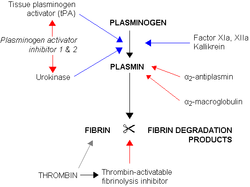
Carboxypeptidase B2
Encyclopedia
Carboxypeptidase B2 also known as carboxypeptidase U (CPU), plasma carboxypeptidase B (pCPB), or thrombin-activable fibrinolysis inhibitor (TAFI) is an enzyme
that in humans is encoded by the CPB2 gene
.
. When it is activated by proteolysis at residue Arg92 by the thrombin
/thrombomodulin
complex, CPB2 exhibits carboxypeptidase activity. Activated CPB2 reduces fibrinolysis by removing the fibrin
C-terminal residues that are important for the binding and activation of plasminogen.
Carboxypeptidase
s are enzymes that hydrolyze C-terminal peptide bonds. The carboxypeptidase family includes metallo-, serine, and cysteine carboxypeptidases. According to their substrate specificity, these enzymes are referred to as carboxypeptidase A (cleaving aliphatic residues) or carboxypeptidase B (cleaving basic amino residues). The protein encoded by this gene is activated by thrombin
and acts on carboxypeptidase B substrates. After thrombin activation, the mature protein downregulates fibrinolysis
.
Enzyme
Enzymes are proteins that catalyze chemical reactions. In enzymatic reactions, the molecules at the beginning of the process, called substrates, are converted into different molecules, called products. Almost all chemical reactions in a biological cell need enzymes in order to occur at rates...
that in humans is encoded by the CPB2 gene
Gene
A gene is a molecular unit of heredity of a living organism. It is a name given to some stretches of DNA and RNA that code for a type of protein or for an RNA chain that has a function in the organism. Living beings depend on genes, as they specify all proteins and functional RNA chains...
.
Function
CPB2 is synthesized by the liver and circulates in the plasma as a plasminogen-bound zymogenZymogen
A zymogen is an inactive enzyme precursor. A zymogen requires a biochemical change for it to become an active enzyme. The biochemical change usually occurs in a lysosome where a specific part of the precursor enzyme is cleaved in order to activate it...
. When it is activated by proteolysis at residue Arg92 by the thrombin
Thrombin
Thrombin is a "trypsin-like" serine protease protein that in humans is encoded by the F2 gene. Prothrombin is proteolytically cleaved to form thrombin in the first step of the coagulation cascade, which ultimately results in the stemming of blood loss...
/thrombomodulin
Thrombomodulin
Thrombomodulin, CD141 or BDCA-3 is an integral membrane protein expressed on the surface of endothelial cells. In humans, thrombomodulin is encoded by the THBD gene...
complex, CPB2 exhibits carboxypeptidase activity. Activated CPB2 reduces fibrinolysis by removing the fibrin
Fibrin
Fibrin is a fibrous, non-globular protein involved in the clotting of blood. It is a fibrillar protein that is polymerised to form a "mesh" that forms a hemostatic plug or clot over a wound site....
C-terminal residues that are important for the binding and activation of plasminogen.
Carboxypeptidase
Carboxypeptidase
A carboxypeptidase is a protease enzyme that hydrolyzes the peptide bond of an amino acid residue at the carboxy-terminal end...
s are enzymes that hydrolyze C-terminal peptide bonds. The carboxypeptidase family includes metallo-, serine, and cysteine carboxypeptidases. According to their substrate specificity, these enzymes are referred to as carboxypeptidase A (cleaving aliphatic residues) or carboxypeptidase B (cleaving basic amino residues). The protein encoded by this gene is activated by thrombin
Thrombin
Thrombin is a "trypsin-like" serine protease protein that in humans is encoded by the F2 gene. Prothrombin is proteolytically cleaved to form thrombin in the first step of the coagulation cascade, which ultimately results in the stemming of blood loss...
and acts on carboxypeptidase B substrates. After thrombin activation, the mature protein downregulates fibrinolysis
Fibrinolysis
Fibrinolysis is a process that prevents blood clots from growing and becoming problematic. This process has two types: primary fibrinolysis and secondary fibrinolysis...
.
 |

